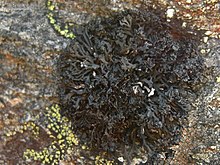| Cornicularia | |
|---|---|

| |
| Cornicularia normoerica | |
| Scientific classification | |
| Domain: | Eukaryota |
| Kingdom: | Fungi |
| Division: | Ascomycota |
| Class: | Lecanoromycetes |
| Order: | Lecanorales |
| Family: | Parmeliaceae |
| Genus: | Cornicularia (Schreb.) Ach. (1803) |
| Type species | |
| Cornicularia normoerica (Gunnerus) Du Rietz (1926) | |
| Synonyms | |
| |
Cornicularia is a genus of lichenised ascomycetes in the large family Parmeliaceae. It is a monotypic genus, with a single currently accepted species, the saxicolous lichen Cornicularia normoerica. This species has an erect caespitose growth form, and is sometimes referred to as the brittle lichen.
Taxonomy
Cornicularia was originally proposed as a section of the genus Lichen by Johann Christian Daniel von Schreber in 1791. Erik Acharius promoted it to generic status in 1803.
References
- Wijayawardene, Nalin; Hyde, Kevin; Al-Ani, Laith Khalil Tawfeeq; Somayeh, Dolatabadi; Stadler, Marc; Haelewaters, Danny; et al. (2020). "Outline of Fungi and fungus-like taxa". Mycosphere. 11: 1060–1456. doi:10.5943/mycosphere/11/1/8. hdl:10481/61998.
- Crespo, A.; Lumbsch, H. T.; Mattsson, J. E.; Blanco, O.; Divakar, P. K.; Articus, K.; Wiklund, E.; Bawingan, P. A.; Wedin, M. (August 2007). "Testing morphology-based hypotheses of phylogenetic relationships in Parmeliaceae (Ascomycota) using three ribosomal markers and the nuclear RPB1 gene". Molecular Phylogenetics and Evolution. 44 (2): 812–824. doi:10.1016/j.ympev.2006.11.029. PMID 17276700.
- von Schreber, Johann Christian Daniel (1791). Genera plantarum (in Latin). Vol. 2. Frankfurt am Main: Suntu Varrentrapii et Wenneri. p. 768.
- Acharius, E. (1803). Methodus qua Omnes Detectos Lichenes Secundum Organa Carpomorpha ad Genera, Species et Varietates Redigere atque Observationibus Illustrare Tentavit Erik Acharius (in Latin). Stockholm: F.D.D. Ulrich. p. 300.
External links
- Cornicularia normoerica at the Stridvall's Botanical Site
- Cornicularia normoerica at Sharnoff Photos
| Taxon identifiers | |
|---|---|
| Cornicularia | |
This Parmeliaceae-related article is a stub. You can help Misplaced Pages by expanding it. |